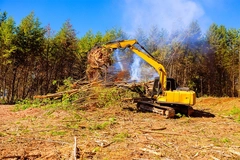
- Industry news
Industry news
- Category news
Category news
- Reports
- Key trends
- Multimedia
- Journal
- Events
- Suppliers
- Home
- Industry news
Industry news
- Category news
Category news
- Reports
- Key trends
- Multimedia
- Events
- Suppliers
AI transforming farming practices across Asia: Addressing labor shortage and preserving heritage
20 Nov 2023 --- A digital transformation is taking root in Asia’s agriculture sector, marked by the growing adoption of artificial intelligence to manage labor-intensive, high-tech farming tasks. This shift is changing the way traditional Asian farms cultivate and harvest, offering solutions to sustainable farming and rural development.
Innovators in the region’s farming industry are actively addressing challenges, particularly focusing on labor shortages and heritage-led innovation. Local businesses are emphasizing regional innovation, recognizing its significance for rural development and industry digitalization.
Takanori Fukao, a robotics professor at the University of Tokyo, suggests that Asian countries are exploring a new frontier in agriculture. Fukao anticipates a future where farms are strategically prepared to maximize the efficiency of robots.

Aging Asia and technological agriculture innovations
In the coming decades, Asia is on track to become one of the oldest regions in the world.
In countries such as Japan, the population is aging rapidly, and the labor force is shrinking. The current population of Japan, standing at approximately 124 million people, is projected to decline by 30% by the year 2070, according to the latest estimate by the National Institute of Population and Social Security Research in April.
Farmers in Saitama Prefecture, Japan, use four-wheeled AI robots to harvest ripe cucumbers selectively. The robot was developed by start-up Agrist Inc. and uses a camera to assess the size of cucumbers and AI to determine the right time to harvest crops.
It roughly cuts off one to three spheres every two minutes before placing them in a case. Additionally, the robot demonstrates precision in positioning its arm relative to the cucumbers, ensuring their stems remain undamaged during harvesting.
 Starting with greenhouse cultivation where harvesting robots can move easily, the likelihood of their integration into open-field cultivation is anticipated to rise (Image credit: Inaho Inc).Japan’s venture into smart agriculture doesn’t stop at its borders. Inaho Inc. has leased an AI-equipped robot capable of picking cherry tomatoes to a farm in the Netherlands. This technology, which selects ripe tomatoes for harvest, embodies the intricate balance between machine precision and delicate crop handling.
Starting with greenhouse cultivation where harvesting robots can move easily, the likelihood of their integration into open-field cultivation is anticipated to rise (Image credit: Inaho Inc).Japan’s venture into smart agriculture doesn’t stop at its borders. Inaho Inc. has leased an AI-equipped robot capable of picking cherry tomatoes to a farm in the Netherlands. This technology, which selects ripe tomatoes for harvest, embodies the intricate balance between machine precision and delicate crop handling.
In Malaysia, Mimos Berhad, a government agency, has partnered with Ancom Nylex Berhad and German company Helm AG, introducing farmers to precision farming platforms. This initiative grants farmers free access to satellite data and AI technology, enabling them to monitor crops and improve yields efficiently.
Preserving traditions through AI farming
In ASEAN countries, businesses are adopting AI in insect farming. Insects have been a part of the traditional diet in some Southeast Asian countries for centuries. They are also a sustainable source of protein that is gradually gaining popularity worldwide.
According to Entoverse, a Singapore start-up, AI-based systems can help insect farmers monitor and optimize breeding conditions. The company has developed an artificial intelligence engine for managing crickets farms. Their technology is currently being used by Cricket One, the biggest cricket farm in Vietnam, to detect diseases in the early stages.
Another innovation led by local cuisine revolves around using lion-head geese, a crucial ingredient in crafting traditional marinated goose dishes in Cantonese cooking.
Chinese breeders have relied on experience-based methods in raising these geese for centuries. This year, Shenzhen University has developed an AI program that increases the survival rate of lion-head geese by 30%.
Zibo Lin from Shenzhen University tells Food Ingredients First: “In the past, diseases such as duck plague, fowl cholera, and E. Coli may have posed a severe threat to lion-head geese farming. When a flock encountered one of these infectious diseases, and farmers could not timely identify them, it could result in the death of many geese overnight.”
“Now, by utilizing AI, farmers can detect diseased geese much earlier and take timely treatment measures.” The lion-head goose has a large body, a deep and wide head, and large sarcomas (Image credit: Shenzhen University).
The lion-head goose has a large body, a deep and wide head, and large sarcomas (Image credit: Shenzhen University).
The program provides real-time monitoring and alerts for the geese’s well-being. It displays data on temperature, humidity, and PM2.5 levels, contributing to more digitized and efficient poultry farming practices.“These aspects are crucial in terms of food safety and quality, which are highly valued by consumers,” Lin explains.
“Leveraging AI in farming can improve the production output of lion-head goose farming, allowing the regional delicacy to tap into the demand of a larger market.”
“Looking ahead, the application of AI in the traditional farming industry will for sure become more extensive and in-depth. Systems for automated feeding, monitoring, and controlling will reduce labor pressure and improve the quality of products while meeting the needs of the agriculture industry.”
By Sichong Wang











